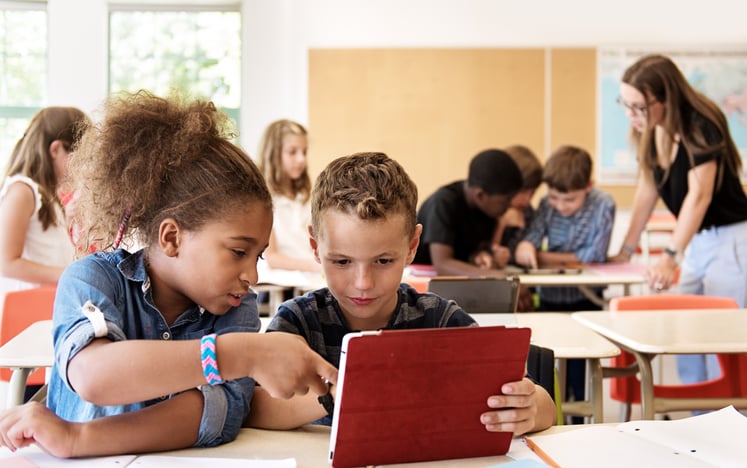3 Ways to Teach Social Initiations to Autistic Students
You may think social interactions come naturally for all children, but for autistic children, it brings a unique world of challenges. Learning social initiation skills can make an enormous difference for autistic children in improving their relationships with peers and family members. Whether you are a teacher, principal, parent, or grandparent, you can help!
Why is social initiation so important?
Every day, children initiate social interactions by asking questions, sharing stories, playing, and more. Social interactions help us build relationships with friends, family, and our community. With the proper social skills, we learn from those around us and develop different hobbies and interests. These skills helped us grow into the people we are today.
One of the first signs of a diagnosis of autism is when young children have difficulty initiating social interactions. Once there is recognition that a child is struggling with this skill it is crucial to provide social and behavioral interventions. Research has shown there are 3 different ways to help elementary-aged autistic students grow socially These interventions can result in increasing and improving interactions with others.
1. How to Use Peer-Mediated Interventions
Peers can be used to conduct role plays and use positive reinforcement in interacting with autistic children. Peers can be trained by guided discussions, worksheets, and stories. Peer mediation helps children learn within a natural and comfortable environment. These interventions can take place during recess, academic tasks, social groups, and other times during the school day.
Are you a teacher? Then you should consider sitting a trained peer next to an autistic child during a structured activity. The trained peer and the child will work together to complete the task while interacting throughout the whole activity. An example of an intervention could be having a peer ask the autistic child for a pencil. This would model social initiations while in a natural environment.
Planning is key for this intervention to be effective. Ask yourself ahead of time: What is the target skill? What peer should I use? Where should this be implemented? And, how am I going to evaluate progress? Simple paper and pen data tracking tools can be used to track improvements.

2. How to Use Textual Prompts and Script Fading
Textual prompts and script fading entail a multi-step process. First, decide on the child's target verbal initiation. For example, “Do you want to play?” Show this to the student on a card and have the child read it. As the child shows positive successful interactions, the prompting can fade by removing one word at a time. Until you just have “Do __ ___ __ ___?” on the card.
When using textual prompting and script fading it is important to think of “most to least” prompting. As the student shows progress, fading prompts help the student gain independence. This takes patience on your part!
Some other examples that can be used to help the student develop a ‘bank’ of social cues include “My name is Rachel.” or “My favorite food is pizza.” As they memorize these sentences and use them appropriately you can continue to add initiation texts.

3. How to Use Video-Based Interventions
Video modeling is when autistic children watch videos of other children interacting positively with peers. Another technique used is called self-modeling. This is when a child is recorded and then watches themselves and self-reflects.
It is not difficult to implement! Start by focusing on one skill at a time to avoid confusion or misunderstanding by the student. A good opportunity to use video modeling could be to teach turn-taking. The video can model two peers taking turns while also using verbal cues such as “my turn” and “your turn” as well as reinforcement such as “great job”. Another example of when video modeling is appropriate is when teaching a student how to properly greet someone. This could include, shaking hands, personal space, and proper etiquette such as saying “Mr. and Mrs.”
Videos can even be easily accessible by having them on student laptops, iPads, or cell phones!
Who am I and how can I help?
You may be thinking to yourself, what can I do? Below are ways you can help based on your role in a child or student’s life.
I am a Parent or Grandparent
Autistic children are so unique and special in their own ways. Accept your child for who they are and enjoy the successes. Show your child how much you love them, this will help them grow the most! Provide your child with constant positive reinforcement when they show you new skills such as initiating any kind of contact with anyone. They are working hard and they want you to know that! Support their interests and work with their strengths. Provide them with multiple ways to grow socially. Bring your child to the park, supermarket, and birthday parties to help foster their growth. The more experiences, the better.
I am a Teacher
Are you a special education teacher or a general education teacher? Or maybe you serve both? Whatever teacher you are, you spend 7-8 hours a day with your students. You serve as a leader, a role model, and a friend to all your students. How can you foster their social skills? Think about what small changes you can make during the day to encourage more social interactions. Students can be given more opportunities throughout the day to practice social interaction by working with different peers. How can you modify certain activities? Lessons can be planned to encourage social initiation, such as utilizing partner work or participating in team-building activities. The possibilities are endless.
I am a Principal
Does your school have special education programs? Are the autistic students at your school included? How much are they included? Autistic students need consistent daily interactions with peers. As a principal, what changes in your school can you make to provide more inclusive opportunities? By providing more inclusion opportunities, it will allow the students to practice their social initiation skills.
Think about the endless social interactions students can make with each other at lunch and recess as well as activities during the day such as morning meetings or partner work.
So what are you waiting for? Go out there and make a difference!
We hope you enjoyed the information in this article. STAGES® Learning also offers free downloadable resources to support teaching and learning with autistic individuals. Start with our free Picture Noun Cards and see our collection of other downloadable resources here!

Sydni Pakula
Sydni currently is an elementary autism teacher serving students in grades 3-5. She has also worked in a special education school with students in middle school. Sydni holds a Bachelor's Degree in Elementary and Special Education from University of Delaware. She also holds a Master’s degree in Exceptional Children and Youth: Autism and Severe Disabilities from the University of Delaware. Sydni recently received her Administrative Certificate from McDaniel College.




